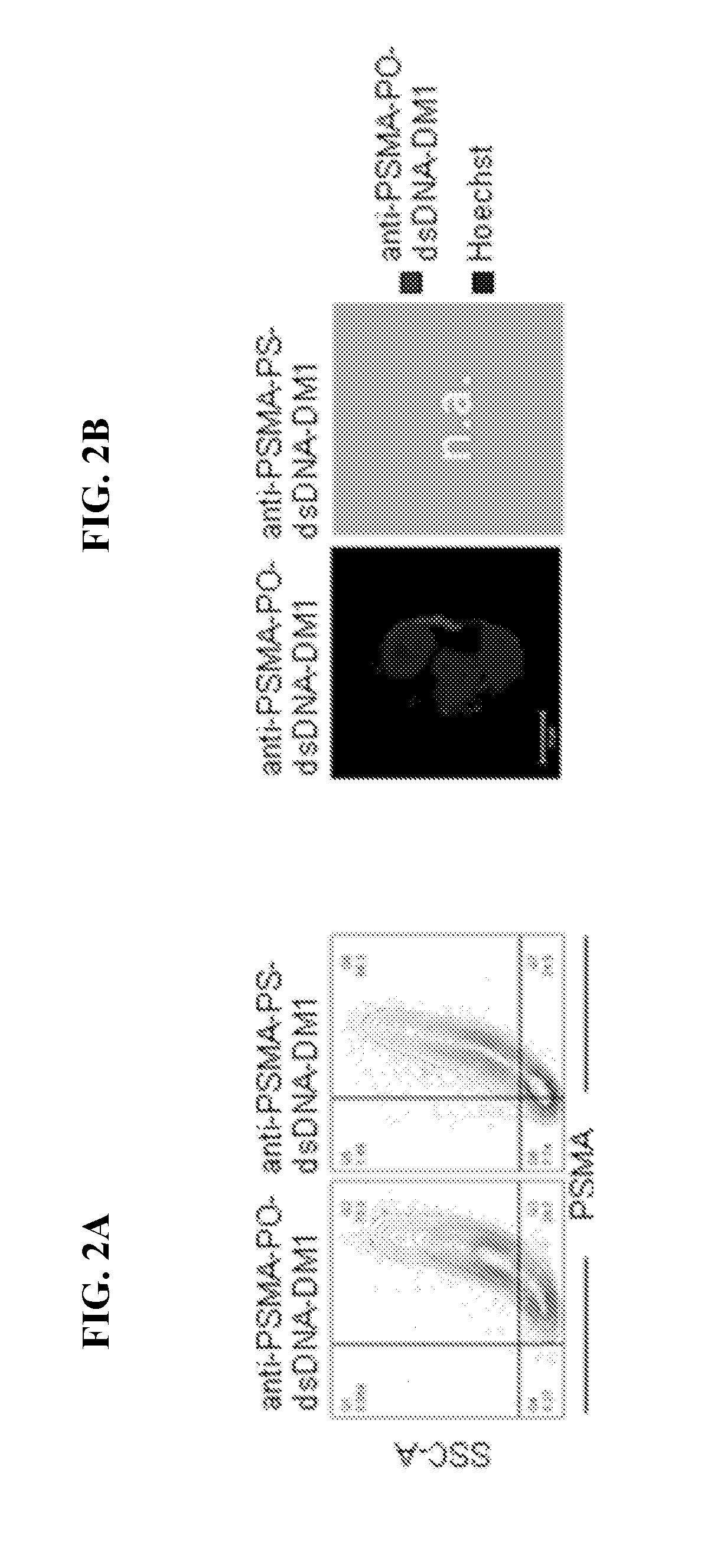Therapeutic cell internalizing conjugates
- Summary
- Abstract
- Description
- Claims
- Application Information
AI Technical Summary
Benefits of technology
Problems solved by technology
Method used
Image
Examples
example 1
[0198]Production of antibody-drug-conjugates (ADCs) specifically binding and internalizing into tumor cells (Cell-internalizing ADCs).
[0199]Drug-modified antibodies (anti-PSMA) raised against proteins (PSMA) specifically expressed on the surface of tumor cells (prostate carcinoma) will recognize tumor cells. The conjugated drug (DM1) will exert cytotoxic activity once it localizes intracellular. However, the major obstacle of cellular internalization is addressed by using a linker consisting of a phosphorothioated (PS) sense / antisense dsDNA-oligo. A non-phosphorothioated sense / antisense dsDNA-oligo (PO) linking antibody and drug was employed as a non-internalizing and therefore non-toxic control. Once human PSMA antibodies were non-covalently linked to sense phosphorothioated ssDNA-oligo and drug non-covalently linked to antisense phosphorothioated ssDNA-oligo using Streptavidin / Biotin, we subjected ADCs to gel filtration upon hybridization and purified fractions were collected (FIG...
example 2
[0202]Here, we used a tumor antigen recognizing antibody raised against PSMA highly expressed by human carcinoma of the prostate for directed intracellular delivery of STAT3siRNA targeting the STAT3 mRNA transcript. Since the PSMA antibody is known to exert no or very little cell internalizing activity, we facilitated cell internalization by synthetic fusion of phosphorothioated ssDNA with the antisense STAT3siRNA strand. The full conjugate is generated by (i) hybridization of siRNA strands and (ii) non-covalent linkage of biotinylated phosphorothioated ssDNA-siRNA resulting in anti-PSMA-avidin-biotin-phosphorothioated ssDNA-siRNA (FIG. 4).
[0203]After conjugating the major components (i) PSMA-avidin and (ii) PS-ssDNA / siRNA-biotin, we purified conjugates comprising of scrRNA (left panel) and STAT3siRNA (right panel) fused to anti-PSMA antibody (FIGS. 5A and 5B).
[0204]Next, we assessed cellular internalization of the anti-PSMA-PS-ssDNA-RNAi conjugates. Therefore, human prostate carcin...
embodiments
[0206]Embodiment 1. A cell-penetrating conjugate comprising: (i) a non-cell penetrating protein; (ii) a phosphorothioate nucleic acid; (iii) a first linker attaching said phosphorothioate nucleic acid to said non-cell penetrating protein; and (iv) a second linker attaching said phosphorothioate nucleic acid to a therapeutic moiety, wherein said phosphorothioate nucleic acid enhances intracellular delivery of said non-cell penetrating protein.
[0207]Embodiment 2. The cell-penetrating conjugate of embodiment 1, wherein said first linker comprises a first biotin-binding domain non-covalently attached to a first biotin domain.
[0208]Embodiment 3. The cell-penetrating conjugate of embodiment 2, wherein said first biotin-binding domain is a first avidin domain.
[0209]Embodiment 4. The cell-penetrating conjugate of embodiment 2, wherein said first biotin-binding domain is a first streptavidin domain.
[0210]Embodiment 5. The cell-penetrating conjugate of embodiment 4, wherein said first strepta...
PUM
| Property | Measurement | Unit |
|---|---|---|
| Time | aaaaa | aaaaa |
| Length | aaaaa | aaaaa |
| Molecular weight | aaaaa | aaaaa |
Abstract
Description
Claims
Application Information
 Login to View More
Login to View More - R&D
- Intellectual Property
- Life Sciences
- Materials
- Tech Scout
- Unparalleled Data Quality
- Higher Quality Content
- 60% Fewer Hallucinations
Browse by: Latest US Patents, China's latest patents, Technical Efficacy Thesaurus, Application Domain, Technology Topic, Popular Technical Reports.
© 2025 PatSnap. All rights reserved.Legal|Privacy policy|Modern Slavery Act Transparency Statement|Sitemap|About US| Contact US: help@patsnap.com



